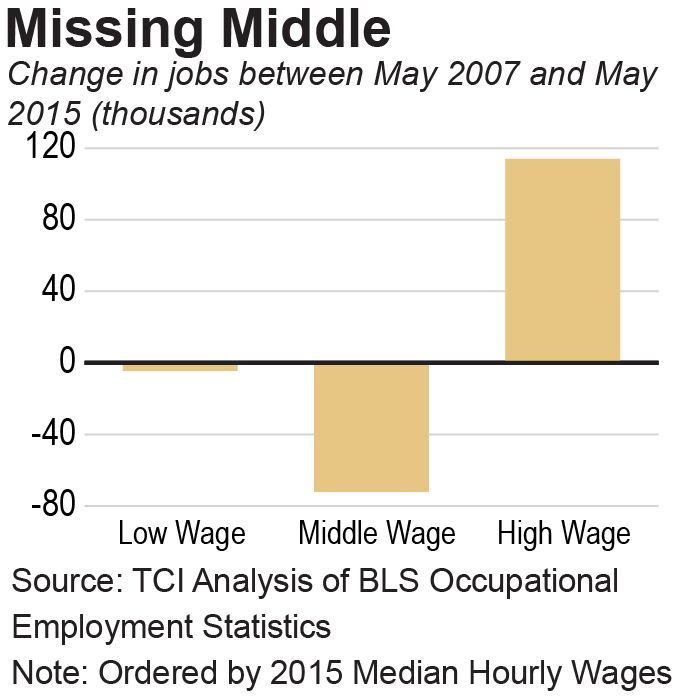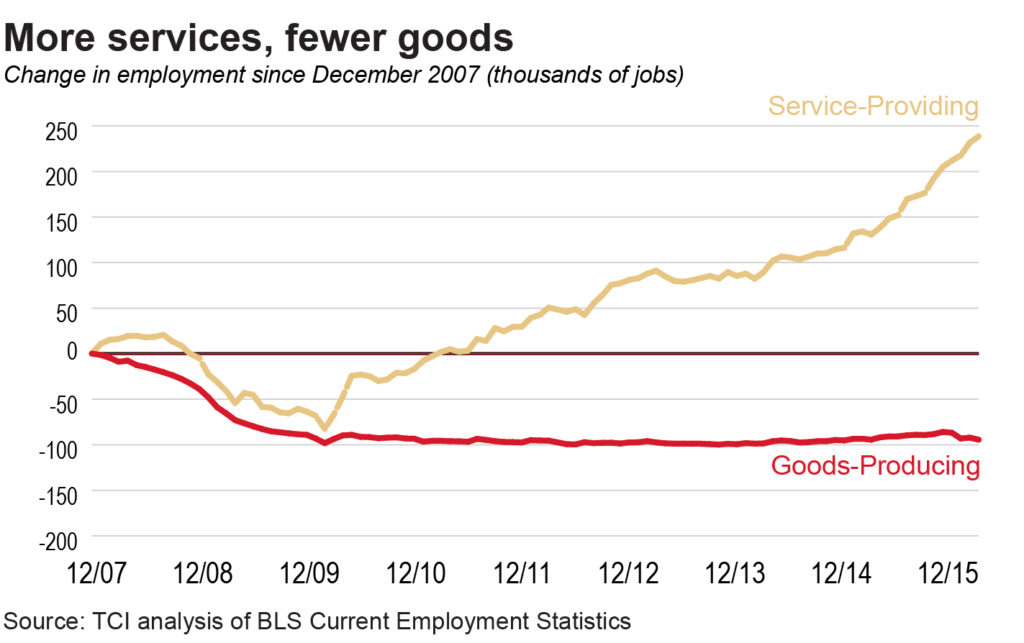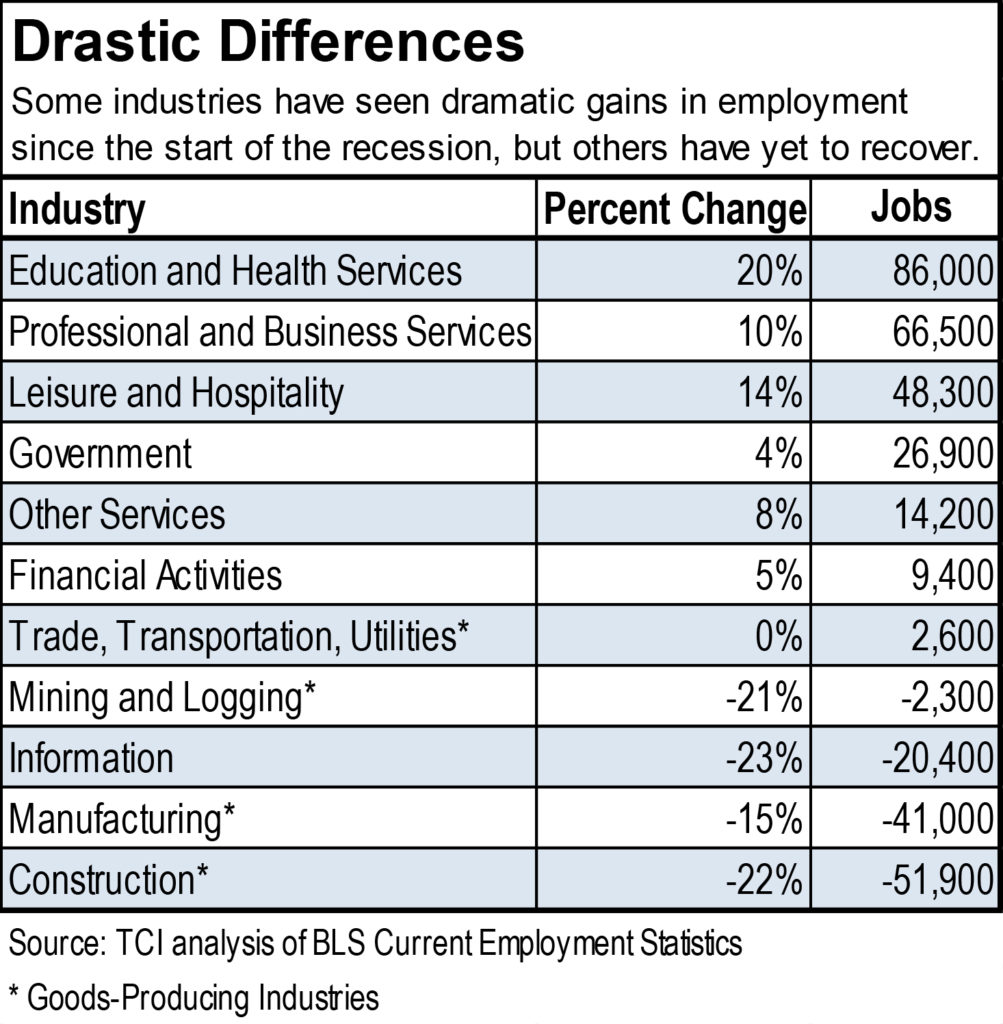April 26, 2016
Patchwork Recovery
As Job Gains Spread, Gaps Are Becoming More Stark
There are finally more jobs in Virginia than before the recession started eight years ago. Today, workers in high-wage occupations, certain industries such as education and health services, and several of Virginia’s larger communities are better off than before the recession. In many communities, occupations, and industries, though, people still struggle. Growth in low- and middle-wage occupations hasn’t materialized. Virginia’s goods-producing industries never recovered. And many of Virginia’s communities are only a little better off today than during the last recession.
The effects of the 2007-2009 recession were shallower but longer felt in Virginia than in many other states, in part because of Virginia’s high concentration of government-related jobs. While jobs in construction and manufacturing disappeared quickly, Virginia’s robust public sector limited statewide job losses. But that has turned out to be a double-edged sword. Several years of federal government austerity in the aftermath of the recession has substantially limited the recovery in Virginia while many of the hardest hit states in the country have seen much higher levels of post-recession economic growth.
Progress Beyond NOVA
For years, Northern Virginia was the lone bright spot in the state. By the fall of 2010, just over a year after the end of the recession, Northern Virginia had recaptured the jobs it lost during the recession. It took the rest of Virginia until the summer of 2015 to regain those jobs. Though Northern Virginia still leads the state with 96,700 more jobs than before the recession, other areas are coming back. Richmond, Charlottesville, and Winchester together have gained 61,300 jobs, and, overall, areas outside of Northern Virginia are now 41,500 jobs above pre-recession levels.
There are other signs of progress, too. Since peaking at 7.4 percent in February 2010, the statewide seasonally adjusted unemployment rate has fallen to 4.0 percent, and total unemployment has fallen to 171,000 from 306,000. While a positive sign of progress, those numbers mask the fact that many Virginians in their prime working years have dropped out of the labor force altogether and aren’t counted as unemployed.
In addition, unlike many other states, net job gains since the recession in Virginia have almost exclusively been in occupations with high wages. Between May 2007 and May 2015, the top third of occupations at the highest end of the wage scale – like engineers and financial specialists – added about 114,000 jobs. These are occupations with median wages ranging from $25.66 per hour to $68.70 per hour in May 2015.
Left Behind
While it might sound good that more total people have high-wage jobs in Virginia than before, Virginians in many other occupations, industries, and communities have been left behind. Middle-wage occupations – those that pay median hourly wages between $15.03 and $25.61 as of May 2015, such as financial clerks, construction workers, and law enforcement personnel – lost about 72,000 jobs. And low-wage occupations such as retail sales, food processing, and material moving, with median hourly wages ranging between $8.83 and $14.96, lost about 4,400 jobs between May 2007 and May 2015.
Adding high-wage jobs is better than adding middle- or low-wage jobs, but a healthy economy is one where everyone has opportunity, with a spectrum of jobs and wages suited to all skill levels. That’s a pathway to broad prosperity that Virginia is not yet on.
When we look at industries – the type of activity in a workplace – rather than occupations – the kind of work a person does to earn a living – we also see that job losses compared to before the recession are concentrated in certain sectors, while others have bounced back.
The recession damaged both service-providing industries like Education and Health Services, and Professional and Business Services, as well as goods-producing industries like Construction, and Manufacturing. Since the recession ended, service-providing industries have added hundreds of thousands of jobs, but employment in goods-producing industries hasn’t fully recovered.
Finally, the recovery has reached more communities than a few years ago, but many areas in Virginia lack opportunity and economic growth. Lynchburg and Virginia Beach-Norfolk-Newport News have more than 8,400 fewer combined jobs than before the recession. Parts of the state not in Metropolitan Statistical Areas like Danville, Wise Coutny, and the Eastern Shore have 15,700 fewer combined jobs than before the recession.
The employment growth felt in most of the state simply isn’t reaching Hampton Roads, which has disproportionately suffered because of defense cuts under federal government austerity, it isn’t reaching Southside Virginia where textile and furniture manufacturing have declined, and it isn’t reaching the coal fields of rural western Virginia.
Coal, once the staple of rural Virginia’s economy, has been decimated by natural gas production in other states and by the collapse of the once-in-a-lifetime international demand for metallurgical coal. The bursting of an unprecedented housing bubble has sidelined construction workers. International conditions have dragged on manufacturing while productivity gains have reduced the number of employees required to make goods.
Seven-and-a-half years after the worst of the financial crisis, the remaining scars of the last recession are likely no longer the result of the business cycle that will heal simply with the passage of time. The structural changes that have occurred in the economy demand looking forward instead of to the past.





